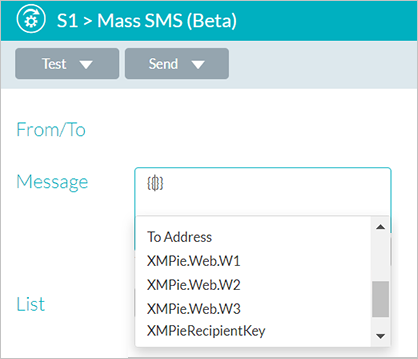
Prerequisite: PersonalEffect version 10.2
Each web touchpoint in your project is represented in the Circle project by an automatic link ADOR object which we call Web ADOR. This ADOR can be easily added to your email or SMS. In case of print documents, the ADOR should be created manually.
To add a web link to an email document:
1. Create a document as described in Creating an Email Document from the Touchpoint.
2. In the online email editor, place your cursor where you wish to add a link to the web touchpoint.
3. On the left panel, select Special ADORs.

4. Select the
required web ADOR and drag it into the document.
A web ADOR consists of an “XMPie.Web" prefix, followed by the touchpoint's
friendly ID, for example: XMPie.Web.W1
A reference to the web touchpoint is inserted into your email body. This reference is a URL to the specific webpage configured in the web touchpoint. If a friendly URL was configured for the web touchpoint, the web ADOR will resolve to the friendly URL. If not, the web ADOR will resolve to the full URL.
5. Click Save.
You can now use this document as an email body. Once the email is sent and the recipient clicks the new link, the recipient is redirected to the webpage represented by the web ADOR.
To add a web link to SMS:
1. Configure your SMS touchpoint, as described in Configuring SMS touchpoints.
2. In the
Message area, type two open curly
brackets to display the ADOR list, and then select the web ADOR.
A web ADOR consists of an “XMPie.Web" prefix, followed by the touchpoint's
friendly ID, for example: XMPie.Web.W1

A reference to the web touchpoint is inserted into your SMS message. This reference is a URL to the specific webpage configured in the web touchpoint. If a friendly URL was configured for the web touchpoint, the web ADOR will resolve to the friendly URL. If not, the web ADOR will resolve to the full URL.
To add a web link to a print document:
1. Add a new link ADOR to the plan file.
2. Define the ADOR expression. It should be a call to the GetTouchpointData QLingo function.
Example: GetTouchpointData("W1", "URL")
This returns the URL of the web touchpoint W1.
3. The ADOR is now ready for use in your print document.
Once the document is ready and the recipient clicks the new link or scans the QR code, the recipient is redirected to the webpage represented by this ADOR. If a friendly URL was configured for the web touchpoint, the ADOR will resolve to the friendly URL. If not, the ADOR will resolve to the full URL.